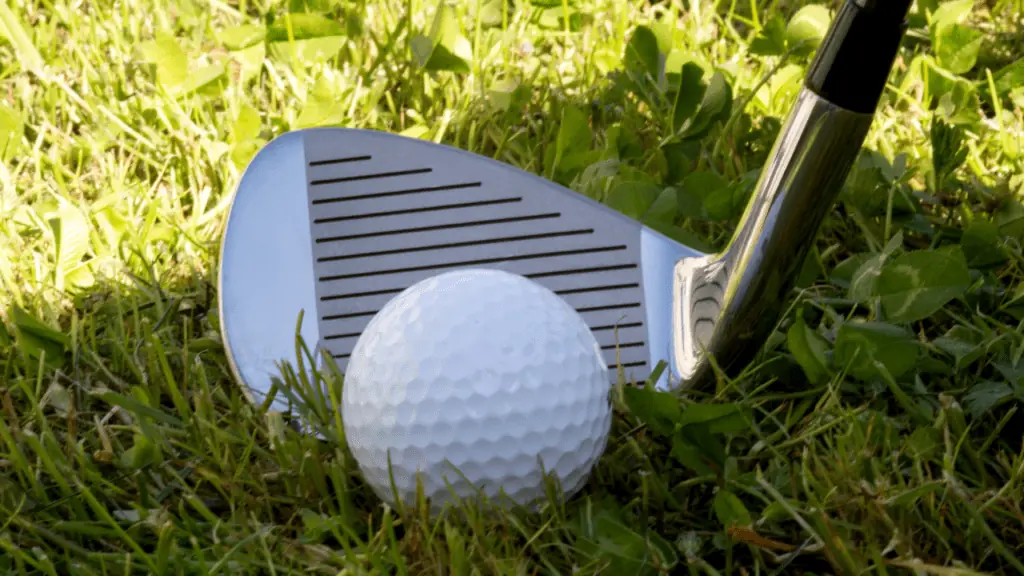Table of Contents
Deciding if single length irons are right for you? In this article, our golf expert covers the pros and cons, as well as the best one length irons on the market.
Bryson DeChambeau made waves in 2017 as he showcased Cobra’s one length irons to the public for the first time. Despite the hype, this was not the first rodeo for single length golf clubs, as Bobby Jones and Moe Norman employed them in the 1930s and 1950s, respectively.
In this post, I explain what length these golf clubs are and how they encourage greater consistency in your setup. Plus, I will reveal the pros and cons of the one length design before revealing the best options for female and male golfers.
⛳️ Read Next: 10 Best Fairway Woods For Seniors to Improve Accuracy
One Length Irons Explained
Here are some common questions when it comes to single length irons.
What are one length irons?
One length irons are clubs containing the same shaft length throughout the set, usually around 37 to 37.5 inches long. These irons are built to promote consistency in your golf game by allowing you to set up with the same swing and ball position on every shot.
Who should play one length irons?
One length irons suit golfers who operate with a consistent single plane swing, looking to replicate their setup on every swing. In addition, they complement the average golfer struggling for consistency with different-length irons.
The uniformity of one length golf clubs allows you to employ the same ball position for your 5-iron as your pitching wedge. This helps you to induce the same swing on every shot and strike the ball cleanly without worrying that it is too far forward or back in your stance.
The Positives of One Length Irons

Greater Clubface Control
My outings with one length irons helped me control the clubface on long iron shots for cleaner contact, a higher coefficient of restitution (COR), and faster ball speed. This is due to the reduced shaft length on the 4, 5, and 6 irons.
For context, the average 4-iron measures 38.5 to 39 inches, while a 5 and 6-iron range from 37.5 to 38.5 inches in length. As a result, a one length 4-iron is often 1 to 1.5 inches shorter than a standard length option.
Straighter Shots
Thanks to the improved clubface control with single length long irons, I also found it easier to square the clubface at contact. This encouraged straighter shots and improved accuracy on long approach shots compared to my standard-length irons.
Consistent Ball Position
The consistency of my setup with single length irons made it easier to achieve the correct ball position with all my irons. The challenge with standard length constructions is judging where to place the ball in your stance to match the low point of the clubface.
Fortunately, the reduced shaft length for long irons and increase for shorter clubs means you place the ball towards the center of your shaft on all shots. As a result, I found it easier to generate consistent contact with the ball leading to better distance and accuracy in my iron game.
The Negatives of One Length Irons
Setup Takes Time To Adapt To
Despite my love of the consistent setup, it did take some time to adapt before I felt comfortable with single length irons on the golf course. After hitting standard-length irons for 28 years, you can imagine how strange a central ball position and shorter 4-iron felt in my hand.
However, after pushing through the discomfort, the consistent setup paid dividends for my ball striking.
Reduced Long Iron Clubhead Speed
I appreciated the control induced by shortened long irons. Unfortunately, this also led to a drop in clubhead speed. While initially rueing the reduced velocity, I eventually made up for it with a higher smash factor, transforming my ball speed.
Less Short Iron Control
Contrarily to their long siblings, the shorter clubs in single length iron sets produced increased clubhead speed. But, the added velocity, thanks to a longer-than-usual shaft, marginally reduced my control of the clubface. Occasionally, I delivered some horrendous misses with my 9 iron and pitching wedge.
Professional Golfers Who Have Used Single Length Irons

Bryson DeChambeau and Moe Norman are two professional golfers who have utilized single length irons. Funnily enough, Norman is the man I modeled my swing off, given its ease and consistency.
Many authors cite Bobby Jones as playing single length irons in 1930, the year he grabbed the Grand Slam. The statement is not entirely factual, as every second club changed length. His 3 and 4 irons were the same length, then the 5 and 6 measured the same, and this continued down to his golf wedges.
⛳️ Read Next: 10 BEST Cavity Back Irons + Expert Buyers Guide
Will One Length Irons Improve My Game?
One length irons are designed to bring consistency to your ball position, striking, launch, distance, and accuracy. While this proved to be the case in my experience, a golfer still needs to swing smoothly and strike the ball with a square clubface to see results in their shots.
I find one length irons offer the best value to the average golfer in the long irons because it aids your consistency. However, the reduced control on short iron and wedge shots concerns me, causing inconsistent results around the green, leading to a loss of strokes.
You may see game improvement with your long irons overall, given the consistency of each strike. However, short irons are less lenient.
Best One Length Irons For High Handicappers
High Handicappers
Cobra released the AeroJet range in 2023 to offer the average golfer explosive ball speed across an expansive area for a consistent launch. Although Rickie Fowler’s sponsor offers the set in a standard length, I appreciate the consistency of the one length irons.
Cobra engineers built the 5-iron through gap wedge to extend 37.25 inches roughly in accordance with a standard 7-iron. As with all single length irons, I find it easier to replicate my setup and produce a consistent swing and strike.
Besides the single length setup, the AeroJet irons sport a PWR-Bridge Weighting and PWRSHELL Face Design. In my experience, the pair did wonders for my clubface flexibility, boosting energy transfer into impact to impart maximum speed onto the golf ball.
Next, the Highly Optimized Topology (H.O.T) Face expanded the active zone to deliver accelerated velocity across a wide area. As a result, I produced exceptional speed, low spin, and a powerful launch on most shots.
Finally, the regressive offset design sees the long irons carry increased levels to combat slices and promote straighter shots.
PROS
- Exceptional forgiveness
- Generates rapid ball speed on long shots
- High offset in the long irons
- Promotes a high launch
- Crisp acoustics
- best single length irons 2023
CONS
- Expensive for a game improvement irons set
- The increased offset in the long irons reduce workability.
We may earn a commission, at no additional cost to you.

Best Single Length Irons For Mid Handicappers
Mid Handicappers
After assessing our most forgiving same-length golf clubs, we turn to the player’s distance category, which works for mid-handicappers. The Cobra King Forged Tec offers the sound and feel of forged irons with the forgiveness, yardage, and accuracy of player’s distance irons.
Off the bat, I was seriously impressed with the softness of my strikes and the crisp acoustics that followed. This stems directly from the 5-step forging process Cobra engineers exposed the irons to, making them attractive to low and mid handicappers.
Adding to its impeccable feel is the Hollow body Foam Insert which dampened vibrations on off-center hits. In addition, the Foam Insert increased the flexibility of the clubface for maximum rebound on high-impact shots. As a result, I enjoyed a mid-to-high launch on long shots.
The Cobra Golf Forged Tec carries moderate offset in the long irons to combat slices and encourage straighter shots. However, as we enter the realm of the short irons and pitching wedge, the offset reduces to enhance workability.
Finally, Cobra added an extra ¼ inch to these alloy steel shafts compared to the AeroJet, making them 37.50 inches. Also, the approximate length of a 7 iron.
PROS
- Exceptional feel
- Crisp acoustics
- Offset long irons combat slice
- Affordable for a forged irons set
- Flexible clubface
CONS
- The added offset in the long irons reduces workability
- Not ideal for high handicappers
We may earn a commission, at no additional cost to you.

Final Thoughts on Single Length Irons
It took me a while to get used to the idea of single length irons, given my comfortability of playing variable lengths my whole life. However, I came around and eventually enjoyed the consistency of my ball striking, the ease of setup, and the accelerated long iron clubhead speed.
I still have reservations about the shorter irons and wedges because the longer-than-usual shaft and center ball position felt uncomfortable. Plus, I experienced reduced control over the clubface leading to a few erratic shots.
Overall, I feel that one length golf clubs work for players struggling to adapt to varied ball positions and shaft lengths. If you could use more consistency in your iron play, ponder the Cobra AeroJet Irons.
If you’re still undecided on single length irons, you’ll want to read our article on the best golf irons next.
Frequently Asked Questions
Do one length irons reduce distance?
No, in my case, one length irons did not reduce distance, despite less clubhead speed with my long irons. Thanks to its shorter shaft, I generated an impressive smash factor leading to excellent ball speed, a powerful launch, and optimal carry distance.
Do you change ball position with one length irons?
No, you do not change ball position with one length irons for standard, straight shots. The idea of the irons is to promote a consistent setup that enhances your ball striking, smash factor, distance, and accuracy.
However, if you wish to induce a draw, you should still move the ball back in your stance or forwards for a fade.
Are one length irons easier to hit?
Yes, I find longer one length irons easier to hit, given the reduced shaft measurements compared to variable-length irons. The shorter shaft makes it easier to control the clubface and strike the ball in the sweet spot, resulting in a higher smash factor, faster ball speed, and a towering powerful launch.
What is the downside to one length irons?
The downside of one length irons is the reduced control of short irons and less long iron clubhead speed. The longer-than-usual short iron and wedges are challenging to control, leading to more erratic strikes than usual. Conversely, the reduced long iron clubhead speed can cost you distance with a weak smash factor.
Do one length irons go as far?
Yes, in my experience, one length irons go far, thanks to cleaner ball striking, improved smash factor, and a superior coefficient of restitution. These components accelerate speed and generate a high and powerful launch encouraging an enhanced carry and total distance.



